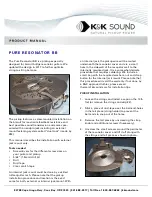
Installing the 40T
4
Installing the 40T
4.1
Installation notes
For the best possible results, a seismometer should be installed on a seismic pier in
a specially-built vault, where conditions are near perfect. Here, wave-trains arriving
at the instrument reflect very well the internal motion of subsurface rock
formations. However, this is not always feasible. For example,
•
instruments may need to be deployed rapidly, perhaps to monitor the activity
of a volcano showing signs of rejuvenation, or to study the aftershocks of a
major earthquake;
•
installations may be required in remote locations, or otherwise in
circumstances where it is infeasible to build a vault.
In these situations, the seismometer and its emplacement need to be considered as a
mechanical system, which will have its own vibrational modes and resonances.
These frequencies should be raised as high as possible so that they do not interfere
with true ground motion: ideally, beyond the range of the instrument.
This is done by
•
standing the sensor on bedrock where possible, or at least deep in well-
compacted subsoil;
•
clearing the floor of the hole of all loose material; and
•
using as little extra mass as possible in preparing the chamber.
In temporary installations, environmental factors are also important. The sensor
needs to be well protected against:
•
fluctuations in temperature;
•
turbulent air flow around walls or trees, or around sharp corners or edges in
the immediate vicinity of the sensor; and
•
vibration caused by heavy machinery (even at a distance), or by overhead
power lines.
This can be done by selecting a suitable site, and placing the instrument in a
protective enclosure. An open-sided box of 5 cm expanded polystyrene slabs, placed
over the instrument and taped down to exclude draughts, makes an excellent
thermal shield.
After installation, the instrument case and mounting surface will slowly return to
the local temperature, and settle in their positions. This will take around four hours
from the time installation is completed.
17
Issue F - June 2019
















































